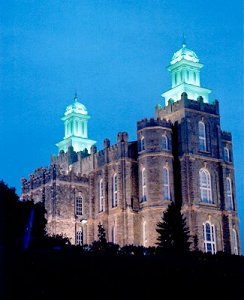












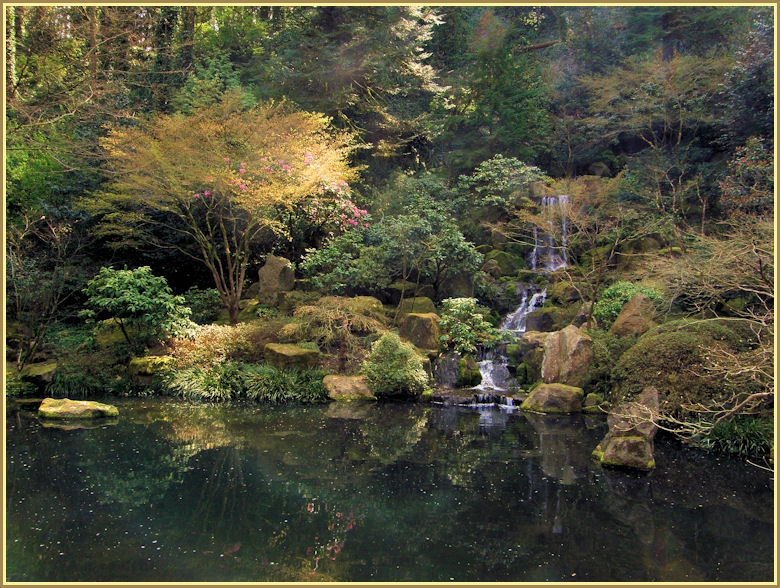




More of Don's
photo series.
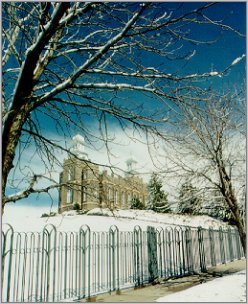
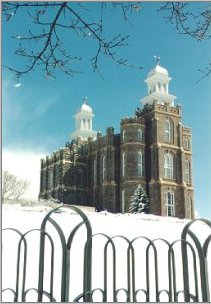
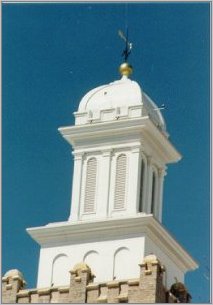
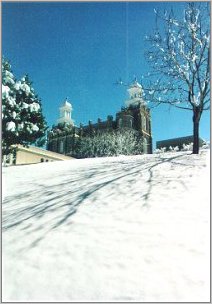
The Logan Temple was dedicated in 1884, the second Utah temple. Most of the older temples are located on Temple Square in the city in which they are located, and the streets are numbered from that square. But in Logan, the streets are numbered from the Logan Tabernacle, not the temple. The temple is a short distance away.
The temple is awe-inspiring to come upon, high above you, large and beautiful. Imagine the sacrifice in time, labor, and money the people of the area exerted to build this edifice.
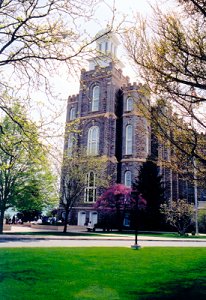

Temple Construction Begins
On the morning of May 16, 1877, Brigham Young and other church officials boarded a train and left Salt Lake City for Logan [75 miles north of Salt Lake City] where they would select a site for the temple. They had recently finished dedicating the St. George Temple on April 6. The site of that temple was dedicated on November 9, 1871. Three years later, some of the people from Cache Valley (Logan area) had the opportunity to actually get first-hand experience on temple construction. Fifty men answered a call to offer their skills and services and traveled to St. George to help build the Mormon edifice.
In the early days of the church Brigham Young had been a temple construction worker. He had worked on the Kirtland (Ohio) Temple in 1835-36. During this time, he displayed his craftsmanship as a carpenter; he was also in charge of painting and finishing that edifice.
When "Brother Brigham" arrived at the Logan site, he remarked that it was the finest situation for a temple he knew of, or had seen in all his travels.
The land on which the temple now stands had been held in reserve from the start. A German emigrant took care of these public grounds for years. It was known as "the pleasure grounds" by those who would use it as a park. The earliest pioneers could see the area being used as an Indian camping ground; the Indians referred to the grounds as "Holy Hill." This was a religious refuge where a tribe would bring their sick and wounded. Here they would pray and place the ill on the hill and even wait days until the afflicted were made well again. This hill was revered by the Indians as a place for consoling, for they felt that the Great Spirit had this area set aside as sacred ground.
"The crews building the temple were the largest single work-force in the Valley even in February 1882, for it was in the winter when most of the rock was hauled from the quarries in Green Canyon, Hyde Park, and Franklin. It was easier to haul the rock on sleighs in the winter than it was in the wagons in the summer. And it must be remembered that in the 1880's when most of the able-bodied men in Cache Valley were farmers, it was during the winter months when they had spare time for the quarries or the sawmills or the canals which had to be built." (Jeff Simmonds)
Friday, May 18, 1877, the seven-year construction project began. The night before the dedication of the site, it had unseasonably snowed four inches. The next day continued to be stormy and therefore President Young remained in his carriage, directing the proceedings from his transportation. After his remarks, Apostle Orson Pratt knelt to bless the temple area.
Next Brigham Young addressed the congregation about the building programs. The saints were encouraged to give benevolently of their labor and goods to aid help and defer the construction costs. The prophet was explicit in his address saying that he wanted the temple to be built with voluntary labor:
"We require the brethren to go with their might and erect a temple and from the architect to the boy who carries the drinking water and the men who work on the building, we wish them to understand that wages are entirely out of the question. We are going to build a house for ourselves and we shall expect the brethren and sisters, neighborhood after neighborhood, ward after ward, to turn out their proportion of men to come here and labor as they shall be notified . . . . We feel to ask the brethren to go to and complete the building in three years from next fall. I think it can be done in that time if we are disposed to." (Brigham Young)
"[President Young] wanted us to go to work at the Logan Temple right away, he said he would give us 3 years to build it but said we could build it in 2 years, he wanted it built as a free will offering to the Lord without mentioning wages, he Blessed the saints, and started back to Salt Lake City at 2 PM on the Train." (Henry Ballard)
--Submitted by Darrin Smith; edited by D.L. Mark
The Logan Utah Temple is the sixth largest of all the LDS temples.
©D.L. Mark 1997-2003
Billings Montana | Boise Idaho | Boston Massachusetts | Bountiful Utah | Cardston Alberta | Columbia River Washington | Denver Colorado | Idaho Falls Idaho | Jordan River Utah | Kirtland Ohio | Laie Hawaii | Las Vegas Nevada | Logan Utah | Los Angeles California | Manti Utah | Medford Oregon | Mesa Arizona | Monticello Utah | Mount Timpanogos Utah | Nauvoo Illinois | Oakland California | Ogden Utah | Portland Oregon | Provo Utah | Reno Nevada | St. George Utah | St. Louis Missouri | Salt Lake | San Diego California | Seattle Washington | Spokane Washington | Temple Lot | Vernal Utah | Washington D.C. | Winter Quarters Nebraska | Temple Index | Back to Don's Web Site Home Page |
